Different perspective of the consequences of CAN syndrome
Authors:
Klimová Žofia 1; Petríková Adamcová Zuzana 1; Petrík Oliver 1; Havlíčeková Zuzana 2
Authors‘ workplace:
II . Klinika pediatrickej anestéziológie a intenzívnej medicíny SZU, Detská fakultná nemocnica s poliklinikou, Banská Bystrica
1; Klinika detí a dorastu, Jesseniova lekárska fakulta Univerzity Komenského, Univerzitná nemocnica Martin
2
Published in:
Čes-slov Pediat 2022; 77 (6): 353-355.
Category:
doi:
https://doi.org/10.55095/CSPediatrie2022/062
Overview
Child abuse and neglect syndrome, known by its abbreviation as syndrome CAN, is one of the most overlooked and underestimated areas of pediatrics. Moreover, research in recent years has already showed, that its severity lies not only in the violent and traumatic behavior towards child, but also in the devastating consequences, that such behavior has. The growing tensions and aggression in society, the deepening of poverty and social disparities, especially in the context of the pandemic and the ongoing military conflict, make the problem even more pressing. Although the global solution of the problem goes beyond our possibilities and competencies as paediatricians and the responsibility for its prevention lies with society as a whole, our role is irreplaceable. We believe that deeper understanding of the mechanisms leading to the long-term consequences, as well as pointing out the severity of the resulting changes, will bring a different perspective of the issue and make work easier for all involved.
Keywords:
abuse – neglect – syndrome CAN – consequences – toxic stress
Sources
1. Felitti VJ, Anda RF, Nordenberg D, et al. Relationship of childhood abuse and household dysfunction to many of the leading causes of death in adults. The Adverse Childhood Experiences (ACE) Study. Am J Prev Med 1998; 14(4): 245–258.
2. Rose EJ, Fishbein DH. Neurobiological consequences of childhood maltreatment. In: Laskey A, et al. Child Abuse: Medical Diagnosis and Management. 4th ed. Itasca: American Academy of Pediatrics 2019: 1019– 1057.
3. Shonkoff JP, Garner AS, et al. The lifelong effects of early childhood adversity and toxic stress. Pediatrics 2012; 129(1): e232–e246.
4. Tierney AL, Nelson CA. Brain development and the role of experience in the early years. Zero to three 2009; 30(2): 9–13.
5. Verešová M. Kruh bezpečia. In: Vargová (ed.). Zborník z odbornej konferencie s medzinárodnou účasťou „Trauma v detstve... čo ďalej?“. Piešťany 25. –26. september 2019. Warszawa: Collegium Humanum – Szkoła Główna Menedżerska 2020: 68–74.
6. Hašto J. Vzťahová väzba: ku koreňom lásky a úzkosti. Trenčín: Vydavateľstvo F 2005.
7. Franke HA. Toxic stress: effects, prevention and treatment. Children (Basel, Switzerland) 2014; 1(3): 390–402.
8. Nemeroff CB. Paradise lost: the neurobiological and clinical consequences of child abuse and neglect. Neuron 2016; 89(5): 892–909.
9. Hornor G. Childhood trauma exposure and toxic stress: what the PNP needs to know. J Pediatri Health Care 2015; 29(2): 191–198.
10. Hašto J. Posttraumatická stresová porucha – prevalencia u psychiatrických hospitalizovaných pacientov. Psychiatr Prax 2011; 12(4): 161–164.
11. Lippard E, Nemeroff CB. The devastating clinical consequences of child abuse and neglect: increased disease vulnerability and poor treatment response in mood disorders. Am J Psychiatry 2020; 177(1): 20–36.
12. Negele A, Kaufhold J, Kallenbach L, et al. Childhood trauma and its relation to chronic depression in adulthood. Depres Res Treat 2015; 2015: 650804.
Labels
Neonatology Paediatrics General practitioner for children and adolescentsArticle was published in
Czech-Slovak Pediatrics

2022 Issue 6
- What Effect Can Be Expected from Limosilactobacillus reuteri in Mucositis and Peri-Implantitis?
- The Importance of Limosilactobacillus reuteri in Administration to Diabetics with Gingivitis
Most read in this issue
- Inborn errors of amino acid, organic acid metabolism and disorders of the urea cycle
- Epidemiological and clinical characteristics of paediatric inflammatory multisystem syndrome temporally associated with SARS-CoV-2 (PIMS-TS) in the Czech Republic
- Supracondylar fractures of humerus in children – overview
- Treatment of sleep disordered breathing with non-invasive positive pressure ventilation (NIV) – our experience
